#reverse image search engine
Text





I keep forgetting to post these! So, here are the Merc paintings I did for class projects lmao
They're mini studies of artists. In order: Nebojsa Zdravkovic, Michael Borremans, Michael Leonard, Odd Nerdrum, and Masami Teraoka
#gopher art#team fortress 2#tf2 medic#tf2 heavy#red oktoberfest#heavymedic#tf2 spy#tf2 sniper#tf2 engineer#tf2 scout#they're a little crusty because the images are postcard sized#the first 4 are acrylic paint. the last one is watercolor#yes i did post the first one before. i've just been waiting to post the others#partially in case my prof were to. like. reverse image search and find these#that would be mortifying
104 notes
·
View notes
Text

#joey jordison#frederic leclercq#sinsaenum#the way reverse image searches would only show me the times fred posted this screenshotted from an instagram post#and i was like oh okay maybe op was a private account or the post was deleted or something and the one with the corner icon is all there is#nope! scrolled back a couple years further today looking for other things and he screenshotted his own post#fucking. why did no search engines have it?? and did no fan download it and post it elsewhere? like. finding things on the internet from#literally four years ago is supposed to be easy isn't it?
13 notes
·
View notes
Note
Hello,
I am Riham.
I have been displaced from the northern part of the Gaza Strip to the south in search of safety, but there is no safe place here. I lost my home and everything I own 💔 and currently, my family and I are living in a tent. I simply do not want to die here. I want to travel and continue my life outside of Gaza to ensure a dignified life for myself and my family, far from fear and homelessness. To cover the travel expenses, I need your help with anything, even if it is small. 🇵🇸🇵🇸
hi riham, thinking of you & your family <3 gofundme link can be found here
2 notes
·
View notes
Text
literally just had a dream in which i was posting on tumblr
#also dreamed i was watching this tv show that was essentially just my unconcious mind attempting to reverse engineer dumbeshi lol#tight af though. this girl stole materials from her magic school to do a forbidden spell#turning the little demons attached to her into sick wings#but she fucked up and cast it too early which meant explosions would when she tried to leave the room#also all the while i was trying desperately to draw pdude and havjng a terrible miserable time (extremely realistic)#i tried to search for references via google images and all the results were just niche alt right memes it was terrible
3 notes
·
View notes
Text
finally got tineye added to firefox and it's like I've freed myself from another tie to my shitty ex. Google reverse image search can suck m
#i use ecosia but i used to have to go to google for their reverse image search. BUT NOT ANYMORE!!!!#shitpost#search engines#tineye#firefox win
4 notes
·
View notes
Text
Can anyone please recommend me a Reverse Image Search alternative to Google Images? All I want to do is find the exact same image I uploaded, sorted by size, but google seems intent on promoting the far inferior Lens feature and not even clicking on the Find Image Source botton works anymore.
#reverse image search#Google lens#I think yandex so far seems closest to what I want#also if anyone can recommend a better search engine full stop that would also be welcome#it is amazing how irrelevant google search results have gotten lately
4 notes
·
View notes
Note
i think the person in your icon is taemin from shinee?? looks a lot like him
H O W !?


Anon please use your powers for good. And thank you
#you just recognized him instantly from those compressed pixels 😭#I had to spend twenty minutes reverse image searching and go thru several search engines#damn if that ain’t a mystery that just got solved#I don’t have a prize for this or anything but you will forever be the one and only whose that boyband member champion. to me#anon you will forever be famous#anon ask
0 notes
Text
Free plagiarism checker Tool
SEOWagon is primarily known as a writing assistant tool, but it also includes a plagiarism checker in its premium version. Grammarly can scan your text against billions of web pages to identify potential instances of plagiarism. While SEOWagon offers a free version, the plagiarism checker is more comprehensive in the premium version.
#seo tools#paraphrasing tool#article rewriter#plagiarism checker#reverse image search#paraphrase tool#reverse image search engine#reverse photo search#image optimizer#keyword
0 notes
Text
Google is going to start scraping all of their platforms to use for AI training. So, here are some alternatives for common Google tools!
Google Chrome -> Firefox
If you’re on tumblr, you’ve probably already been told this a thousand times. But FireFox is an open-source browser which is safe, fast and secure. Basically all other browsers are Chrome reskins. Try Firefox Profilemaker, Arkenfox and Librewolf! Alternatively, vanilla Firefox is alright, but get Ublock Origin, turn off pocket, and get Tabliss.
Google Search -> DuckDuckGo
DuckDuckGo very rarely tracks or stores your browsing data (though they have only been known to sell this info to Microsoft). Don’t use their browser; only their search engine. Domain visits in their browser get shared. Alternatively, you can also use Ecosia, which is a safe search engine that uses its income to plant trees! 🌲
Google Reverse Image Search -> Tineye
Tineye uses image identification tech rather than keywords, metadata or watermarks to find you the source of your image!
Gmail -> ProtonMail
All data stored on ProtonMail is encrypted, and it boasts self-destructing emails, text search, and a commitment to user privacy. Tutanota is also a good alternative!
Google Docs -> LibreOffice
LibreOffice is free and open-source software, which includes functions like writing, spreadsheets, presentations, graphics, formula editing and more.
Google Translate -> DeepL
DeepL is notable for its accuracy of translation, and is much better that Google Translate in this regard. It does cost money for unlimited usage, but it will let you translate 500,000 characters per month for free. If this is a dealbreaker, consider checking out the iTranslate app.
Google Forms -> ClickUp
ClickUp comes with a built-in form view, and also has a documents feature, which could make it a good option to take out two birds with one stone.
Google Drive -> Mega
Mega offers a better encryption method than Google Drive, which means it’s more secure.
YouTube -> PeerTube
YouTube is the most difficult to account for, because it has a functional monopoly on long-form video-sharing. That being said, PeerTube is open-source and decentralized. The Internet Archive also has a video section!
However, if you still want access to YouTube’s library, check out NewPipe and LibreTube! NewPipe scrapes YouTube’s API so you can watch YouTube videos without Google collecting your info. LibreTube does the same thing, but instead of using YouTube servers, it uses piped servers, so Google doesn’t even get your IP address. Both of these are free, don’t require sign-ins, and are open source!
Please feel free to drop your favorite alternatives to Google-owned products, too! And, if this topic interests you, consider checking out Glaze as well! It alters your artwork and photos so that it’s more difficult to use to train AI with! ⭐️
#anti ai#anti ai art#anti ai music#anti ai writing#anti google#google#political#current events#azure does a thing
31K notes
·
View notes
Text

Does anyone know where I can find the good quality version of this image? It's so frustrating because when cross searching on google it'll tell me the original quality is 850x478, but I can't find a way to download it in that quality. This is another version of the image (I'm guessing it's Mayoi promo art):

But I liked the clean white background one...
#It's cute...#It's got Akutagawa stealing glances at Atsushi#Thought asking was worth a try ;;;;;;#Google cross image search has changed and as someone who used it as I use breathing it's been absolutely heartbreaking.#It makes cross searching images so much harder it's awful#Because before when you looked up an image it suggested you the best quality avaible of that image.#And the search got worse every year but it was still functional you know??#But now there's not that anymore. There's no “large” “medium” “small” and instead it only gives you “find image source”#Dude I don't want to find the image source. I've downloaded the image I KNOW the source. What I want is ANOTHER SOURCE with better quality#And I used to get it when I was 10 and I used to get it when I was 15 and I sued to get it when I was 20#And now I don't have it anymore?? It stripes away one of the most powerful search tools on the internet from the public????#It drives me insane. Like why does internet get worse every year that's not how humanity is supposed to work#Sorry. I needed to rant. This makes every quality-freak media archivist (like me) job harder beyond comparison#Btw if you're looking for an alternative Yandex images still does the work... It's not as powerful search engine as google#and it's often going to miss the particular hidden media (y'know- super niche Akutagawa merch from 2018 and stuff)#But for the rest it does a pretty good job. If anything there's still the best quality avaible option#But seriously looking up stuff for aktgw-daily has gotten so much harder ever since this fucked up change to google lens#and it makes me hate the world. I haven't been able to find a way to reverse it but if anyone more tech savy than me who has any idea-#what I'm talking about can help me. Please please hmu I'll be grateful forever#Sorry for the rant I have a lot of pent up rage over this. Stop making broke people's lives harder challenge#random rambles
42 notes
·
View notes
Text

#reverse image search#Free Reverse Image Search#reverse picture lookup#duplicate image checker#reverse search image#reverse photo search#google image search#reverse image search yandex#search reverse image#yandex reverse image search#image search engine
0 notes
Text
Just checking out switch cases and well
this is a little funny

can you imagine purchasing something without checking each and every detail, or ya know, just scrolling to the second image on the site

and then leaving a bad review for something that was YOUR mistake?
#American behavior#also hot tip: if you need to buy something online search for it on amazon and then reverse image search#or type the company's name into a search engine; you'll find what you're looking for quickly; but without giving your money to beelzebub#It's super useful; I usually only buy second hand or hand made things; so reverse image search or similar image search helps me a lot
0 notes
Text
here's a list of mozilla add-ons for all of you tumblrinas out there to have a better internet experience
also, if you like my post, please reblog it. Tumblr hates links but i had to put them so you adhd bitches actually download them <3 i know because i am also adhd bitches
BASIC STUFF:
AdGuard AdBlocker / uBlock Origin : adguard is a basic adblock and with origin you can also block any other element you want. for example i got rid of the shop menu on tumblr

Privacy Badger : this add on will block trackers. if an element contains a tracker it will give you the option to use it or not
Shinigami Eyes: this will highlight transphobic and trans friendly users and sites using different colors by using a moderated database. perfect to avoid terfs on any social media. i will explain how to use this and other add-ons on android as well under the read more cut
THINGS YOU TUMBLINAS WANT:
Xkit: the best tumblr related add on. with many customizable options, xkit not only enhances your experience from a visual standpoint, but provides some much needed accessibility tools
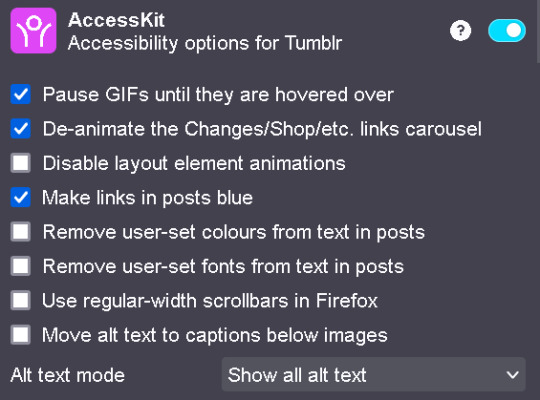

bonus: if you are into tf2 and wanna be a cool cat, you can also get the old version to add cool reblog icons

AO3 enhancer: some basic enhancements including reading time and the ability to block authors and tags
YOUTUBE
Return of the YouTube Dislike : pretty self explanatory
Youtube non-stop: gets rid of the annoying "Video paused. Continue watching?" popup when you have a video in the background
SponsorBlock: gives you options to skip either automatically or manually sponsors, videoclip non music sectors and discloses other type of sponsorships/paid partnerships
Enhancer for YouTube: adds some useful options such as custom play speed, let's you play videos in a window and most important of all, it allows you to make the youtube interface as ugly as your heart desires. I can't show a full image of what it looks like because i've been told its eye strainy and i want this post to be accessible but look at this <3

PocketTube: allows you to organize your subscriptions into groups
YouTube Comment Search: what it says
FINDING STUFF
WayBack Machine: you probably know about this site and definitely should get the add on. this allows you to save pages and access older versions with the click of a button. while you can search wayback using web archives, please get this one as well as it allows you to easily save pages and contribute to the archive.
Web Archives: it allows you to search through multiple archives and search engines including WayBack Machine, Google, Yandex and more.
Search by Image: allows you to reverse image search using multiple search engines (in my experience yandex tends to yield the best results)
Image Search Options: similar to the last one
this next section is pretty niche but...
STEAM AND STEAM TRADING
SteamDB: adds some interesting and useful statistics
Augmented Steam: useful info specially for browsing and buying games
TF2 Trade Helper: an absolute godsend, lets you add items in bundles, keeps track of your keys and metal and your recent trades, displays links to the backpack tf page next to users profiles and more. look it tells me how much moneys i have and adds metal to trades without clicking one by one oh may god

IN CONCLUSION:
oooooh you want to change to firefox so badly, you want to delete chrome and all the chrome clones that are actually just spyware and use firefox
HOW TO USE MOZILLA ADD-ONS ON YOUR PHONE
if you already use firefox on android, you'll know there are certain add-ons compatible with the app, some of them even being made just for the mobile version such as Video Background Play FIx. while most of them are pretty useful, some more specific ones aren't available on this version of the browser, but there's a way of getting some of them to work
you need to download the firefox nightly app, which is basically the same as the regular firefox browser but with the ability of activating developer mode. you can find how to do that here.
once you've enabled it, you need to create a collection with all the add ons you want. i wouldn't recommend adding extensions if the creators haven't talked about phone compatibility, but XKit and Shinigami Eyes should work
also, don't tell the government this secret skater move, but you can try using both the regular firefox browser and nightly so you can have youtube videos in a floating box while you browse social media.
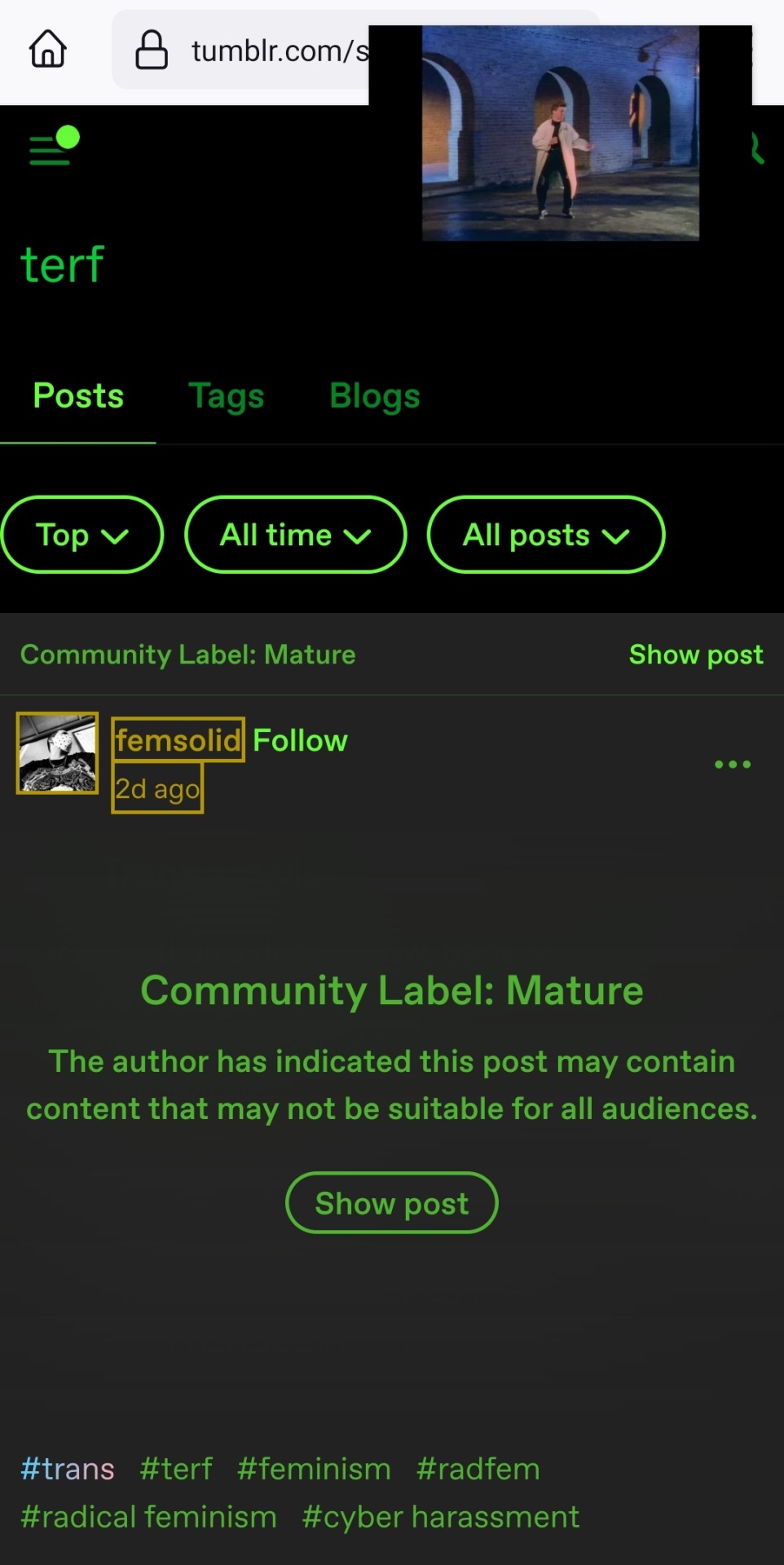
see? i can block this terf while Rick Rolling the people following this tutorial. isn't that tubular?
#zezo talks#firefox#internet safety#accessibility#id in alt text#this will get tagged as tf2 because mine heart desires and its mentioned like twice#tf2#long post#but it's worth it i promise#tumblr
3K notes
·
View notes
Note
Please don’t use midjourney it steals art from pretty much every artist out there without any compensation. I didn’t know this at first and tried it but then during the creation process i saw water marks and Getty image logos (though I’m sure they’ve hidden that now) so it’s definitely stealing.
No, it isn't. And you've taken the wrong lesson from the Getty watermark issue.
AI training on public facing, published work is fair use. Any published piece could be located, examined, and learned from by a human artist. This does not require the permission of the owner of said work. A mechanical apparatus does not change this principle.
All we, as artists, own, are specific expressions. We do not own styles, ideas, concepts, plots, or tropes. We do not even own the work we create in a proper sense. All our work flows from the commons, and all of it flows back to it. IP is a limited patent on specific expressions, and what constitutes infringement is the end result of the creative process. What goes into it is irrelevant, and upending that process to put inspiration and reference as infringement is the end of art as we know it.
The Getty watermark issue is an example of overfitting, wherein a repetitive element in the dataset over-emphasizes specific features to the point of disrupting the system's attempts at the creation of novel images.
No one denies that the SD dataset is trained on images Getty claims to own, but Getty has so polluted the image search functions of the internet with their watermarked images that the idea of a getty watermark has been picked up the same way the AI might pick up the idea of an eye or a tree branch. It is a systemic failure that Shutterstock and Getty can be so monopolistic and ubiquitous that a dateset trained on literally everything public facing on the internet would be polluted with their watermarks.
Watermarks that, by the way, they add to public domain images, and that google prioritizes over clean versions.
The lawsuits being brought against Midjourney and Stable Diffusion are copyright overreach being presented as a theft tissue. The facts of the matter are not as the litigants state. The images aren't stored, the SD weights are a 4 gig file trained on 250 terabytes, roughly 4 bytes per image. It runs local, does not reach out to image sources over IP. All you've got are mathematical patterns and ratios. I would go so far as to say that the class action suit is based on outright lies.
But for a moment, let's entertain the idea that what goes into a work, as inspiration, can be copyrighted. That styles can be stolen. That what goes in defines infringement, rather than what comes out. What happens then?
Well, the bad news is that if Stable Diffusion and Midjourney were shut down tomorrow, Stable Diffusion is in the wild. It runs local, it's user-trainable. In short, the genie isn't going back in the bottle. Plus, the way diffusion AI works, there's no way to trace a gen to its sources. The weights don't work like that. The indexing would be larger than the entire set of stored patterns.
Well good news, there's an AI for that. The current version is called CLIP Interrogator And it works on everything. Not just AI generated, but any image. It can find what style it closely matches, reverse engineer a prompt. It's crude now, but it will improve.
Now, you've already established that using the same patterns as another work is infringement. You've already established that inspiration is theft. And now there's a robot that tells lawyers who you draw like.
Sure, you can fight it in court. If it goes go to court. But who's to say they won't just staplegun that AI to a monetization re-direction bot like youtube has going with their content ID? Awesome T-shirt design you uploaded to your print-on-demand shop... too bad your art style resembles that from a cartoon from 1973 that Universal got as part of an acquisition and they've claimed all your cash. Sure you can file a DMCA counter-notice, but we all know how that goes.
And then there's this fantasy that upending the system would help artists. But who would "own" that style? Is that piece stealing the style of Stephen Silver, or Disney's Kim Possible(TM)? When you work for Disney their contracts say everything you make is theirs. Every doodle. Every drawing. If the styles are copyrightable, a company could hire an artist straight out of school, publish their work under work-for-hire, fire them, and then go after them for "stealing" the style they developed while working for said corp.
Not to mention that a handful of companies own so much media that it is going to be impossible to find an artist that hasn't been influenced by something under their control.
Oh, and that stock of source images that companies like Disney and Universal have? These kinds of lawsuits won't stop them from building AIs with that material that they "own". The power goes into corp hands, they can down staff to their heart's content and everyone else is denied the ability to compete with them. Worst of all possible worlds.
Be careful what wishes you make when holding the copyright monkey's paw.
4K notes
·
View notes
Text
Cloudburst

Enshittification isn’t inevitable: under different conditions and constraints, the old, good internet could have given way to a new, good internet. Enshittification is the result of specific policy choices: encouraging monopolies; enabling high-speed, digital shell games; and blocking interoperability.
First we allowed companies to buy up their competitors. Google is the shining example here: having made one good product (search), they then fielded an essentially unbroken string of in-house flops, but it didn’t matter, because they were able to buy their way to glory: video, mobile, ad-tech, server management, docs, navigation…They’re not Willy Wonka’s idea factory, they’re Rich Uncle Pennybags, making up for their lack of invention by buying out everyone else:
https://locusmag.com/2022/03/cory-doctorow-vertically-challenged/
But this acquisition-fueled growth isn’t unique to tech. Every administration since Reagan (but not Biden! more on this later) has chipped away at antitrust enforcement, so that every sector has undergone an orgy of mergers, from athletic shoes to sea freight, eyeglasses to pro wrestling:
https://www.whitehouse.gov/cea/written-materials/2021/07/09/the-importance-of-competition-for-the-american-economy/
But tech is different, because digital is flexible in a way that analog can never be. Tech companies can “twiddle” the back-ends of their clouds to change the rules of the business from moment to moment, in a high-speed shell-game that can make it impossible to know what kind of deal you’re getting:
https://pluralistic.net/2023/02/27/knob-jockeys/#bros-be-twiddlin
To make things worse, users are banned from twiddling. The thicket of rules we call IP ensure that twiddling is only done against users, never for them. Reverse-engineering, scraping, bots — these can all be blocked with legal threats and suits and even criminal sanctions, even if they’re being done for legitimate purposes:
https://locusmag.com/2020/09/cory-doctorow-ip/
Enhittification isn’t inevitable but if we let companies buy all their competitors, if we let them twiddle us with every hour that God sends, if we make it illegal to twiddle back in self-defense, we will get twiddled to death. When a company can operate without the discipline of competition, nor of privacy law, nor of labor law, nor of fair trading law, with the US government standing by to punish any rival who alters the logic of their service, then enshittification is the utterly foreseeable outcome.
To understand how our technology gets distorted by these policy choices, consider “The Cloud.” Once, “the cloud” was just a white-board glyph, a way to show that some part of a software’s logic would touch some commodified, fungible, interchangeable appendage of the internet. Today, “The Cloud” is a flashing warning sign, the harbinger of enshittification.
When your image-editing tools live on your computer, your files are yours. But once Adobe moves your software to The Cloud, your critical, labor-intensive, unrecreatable images are purely contingent. At at time, without notice, Adobe can twiddle the back end and literally steal the colors out of your own files:
https://pluralistic.net/2022/10/28/fade-to-black/#trust-the-process
The finance sector loves The Cloud. Add “The Cloud” to a product and profits (money you get for selling something) can turn into rents (money you get for owning something). Profits can be eroded by competition, but rents are evergreen:
https://pluralistic.net/2023/07/24/rent-to-pwn/#kitt-is-a-demon
No wonder The Cloud has seeped into every corner of our lives. Remember your first iPod? Adding music to it was trivial: double click any music file to import it into iTunes, then plug in your iPod and presto, synched! Today, even sophisticated technology users struggle to “side load” files onto their mobile devices. Instead, the mobile duopoly — Apple and Google, who bought their way to mobile glory and have converged on the same rent-seeking business practices, down to the percentages they charge — want you to get your files from The Cloud, via their apps. This isn’t for technological reasons, it’s a business imperative: 30% of every transaction that involves an app gets creamed off by either Apple or Google in pure rents:
https://www.kickstarter.com/projects/doctorow/red-team-blues-another-audiobook-that-amazon-wont-sell/posts/3788112
And yet, The Cloud is undeniably useful. Having your files synch across multiple devices, including your collaborators’ devices, with built-in tools for resolving conflicting changes, is amazing. Indeed, this feat is the holy grail of networked tools, because it’s how programmers write all the software we use, including software in The Cloud.
If you want to know how good a tool can be, just look at the tools that toolsmiths use. With “source control” — the software programmers use to collaboratively write software — we get a very different vision of how The Cloud could operate. Indeed, modern source control doesn’t use The Cloud at all. Programmers’ workflow doesn’t break if they can’t access the internet, and if the company that provides their source control servers goes away, it’s simplicity itself to move onto another server provider.
This isn’t The Cloud, it’s just “the cloud” — that whiteboard glyph from the days of the old, good internet — freely interchangeable, eminently fungible, disposable and replaceable. For a tool like git, Github is just one possible synchronization point among many, all of which have a workflow whereby programmers’ computers automatically make local copies of all relevant data and periodically lob it back up to one or more servers, resolving conflicting edits through a process that is also largely automated.
There’s a name for this model: it’s called “Local First” computing, which is computing that starts from the presumption that the user and their device is the most important element of the system. Networked servers are dumb pipes and dumb storage, a nice-to-have that fails gracefully when it’s not available.
The data structures of source-code are among the most complicated formats we have; if we can do this for code, we can do it for spreadsheets, word-processing files, slide-decks, even edit-decision-lists for video and audio projects. If local-first computing can work for programmers writing code, it can work for the programs those programmers write.
Local-first computing is experiencing a renaissance. Writing for Wired, Gregory Barber traces the history of the movement, starting with the French computer scientist Marc Shapiro, who helped develop the theory of “Conflict-Free Replicated Data” — a way to synchronize data after multiple people edit it — two decades ago:
https://www.wired.com/story/the-cloud-is-a-prison-can-the-local-first-software-movement-set-us-free/
Shapiro and his co-author Nuno Preguiça envisioned CFRD as the building block of a new generation of P2P collaboration tools that weren’t exactly serverless, but which also didn’t rely on servers as the lynchpin of their operation. They published a technical paper that, while exiting, was largely drowned out by the release of GoogleDocs (based on technology built by a company that Google bought, not something Google made in-house).
Shapiro and Preguiça’s work got fresh interest with the 2019 publication of “Local-First Software: You Own Your Data, in spite of the Cloud,” a viral whitepaper-cum-manifesto from a quartet of computer scientists associated with Cambridge University and Ink and Switch, a self-described “industrial research lab”:
https://www.inkandswitch.com/local-first/static/local-first.pdf
The paper describes how its authors — Martin Kleppmann, Adam Wiggins, Peter van Hardenberg and Mark McGranaghan — prototyped and tested a bunch of simple local-first collaboration tools built on CFRD algorithms, with the goal of “network optional…seamless collaboration.” The results are impressive, if nascent. Conflicting edits were simpler to resolve than the authors anticipated, and users found URLs to be a good, intuitive way of sharing documents. The biggest hurdles are relatively minor, like managing large amounts of change-data associated with shared files.
Just as importantly, the paper makes the case for why you’d want to switch to local-first computing. The Cloud is not reliable. Companies like Evernote don’t last forever — they can disappear in an eyeblink, and take your data with them:
https://www.theverge.com/2023/7/9/23789012/evernote-layoff-us-staff-bending-spoons-note-taking-app
Google isn’t likely to disappear any time soon, but Google is a graduate of the Darth Vader MBA program (“I have altered the deal, pray I don’t alter it any further”) and notorious for shuttering its products, even beloved ones like Google Reader:
https://www.theverge.com/23778253/google-reader-death-2013-rss-social
And while the authors don’t mention it, Google is also prone to simply kicking people off all its services, costing them their phone numbers, email addresses, photos, document archives and more:
https://pluralistic.net/2022/08/22/allopathic-risk/#snitches-get-stitches
There is enormous enthusiasm among developers for local-first application design, which is only natural. After all, companies that use The Cloud go to great lengths to make it just “the cloud,” using containerization to simplify hopping from one cloud provider to another in a bid to stave off lock-in from their cloud providers and the enshittification that inevitably follows.
The nimbleness of containerization acts as a disciplining force on cloud providers when they deal with their business customers: disciplined by the threat of losing money, cloud companies are incentivized to treat those customers better. The companies we deal with as end-users know exactly how bad it gets when a tech company can impose high switching costs on you and then turn the screws until things are almost-but-not-quite so bad that you bolt for the doors. They devote fantastic effort to making sure that never happens to them — and that they can always do that to you.
Interoperability — the ability to leave one service for another — is technology’s secret weapon, the thing that ensures that users can turn The Cloud into “the cloud,” a humble whiteboard glyph that you can erase and redraw whenever it suits you. It’s the greatest hedge we have against enshittification, so small wonder that Big Tech has spent decades using interop to clobber their competitors, and lobbying to make it illegal to use interop against them:
https://locusmag.com/2019/01/cory-doctorow-disruption-for-thee-but-not-for-me/
Getting interop back is a hard slog, but it’s also our best shot at creating a new, good internet that lives up the promise of the old, good internet. In my next book, The Internet Con: How to Seize the Means of Computation (Verso Books, Sept 5), I set out a program fro disenshittifying the internet:
https://www.versobooks.com/products/3035-the-internet-con
The book is up for pre-order on Kickstarter now, along with an independent, DRM-free audiobooks (DRM-free media is the content-layer equivalent of containerized services — you can move them into or out of any app you want):
http://seizethemeansofcomputation.org
Meanwhile, Lina Khan, the FTC and the DoJ Antitrust Division are taking steps to halt the economic side of enshittification, publishing new merger guidelines that will ban the kind of anticompetitive merger that let Big Tech buy its way to glory:
https://www.theatlantic.com/ideas/archive/2023/07/biden-administration-corporate-merger-antitrust-guidelines/674779/
The internet doesn’t have to be enshittified, and it’s not too late to disenshittify it. Indeed — the same forces that enshittified the internet — monopoly mergers, a privacy and labor free-for-all, prohibitions on user-side twiddling — have enshittified everything from cars to powered wheelchairs. Not only should we fight enshittification — we must.

Back my anti-enshittification Kickstarter here!

If you’d like an essay-formatted version of this post to read or share, here’s a link to it on pluralistic.net, my surveillance-free, ad-
free, tracker-free blog:
https://pluralistic.net/2023/08/03/there-is-no-cloud/#only-other-peoples-computers

Image:
Drahtlos (modified)
https://commons.wikimedia.org/wiki/File:Motherboard_Intel_386.jpg
CC BY-SA 4.0
https://creativecommons.org/licenses/by-sa/4.0/deed.en
—
cdsessums (modified)
https://commons.wikimedia.org/wiki/File:Monsoon_Season_Flagstaff_AZ_clouds_storm.jpg
CC BY-SA 2.0
https://creativecommons.org/licenses/by-sa/2.0/deed.en
#pluralistic#web3#darth vader mba#conflict-free replicated data#CRDT#computer science#saas#Mark McGranaghan#Adam Wiggins#evernote#git#local-first computing#the cloud#cloud computing#enshittification#technological self-determination#Martin Kleppmann#Peter van Hardenberg
888 notes
·
View notes
Text
Luis Serra built a radiotherapy machine in a cave in Spain and I think I can prove it. (Long post warning!)
So I’m minding my own business, sanding a door, when all of a sudden the re4 lore video I have playing hits me with:
“The only way to survive infection is to rid the creature via radiation therapy.”
Snake Meal then went on to say that Leon “used Luis’ equipment to destroy the Plaga within Ashley and himself.”
…So wait a minute, did Luis build a radiation therapy machine in the middle of noplace with Saddler breathing down his neck?

Well shit, he did.
Let’s talk about that.
Quick Preface:
-My knowledge before researching came solely from Plainly Difficult’s YouTube breakdowns of when these machines go wrong, so I’m kind of reverse-engineering ft. Google. I am so far from being an expert it’s laughable.
-I’m narrowing down my search to 2004 and before, preferably 2002 or so. The game takes place in 2004 and Luis was kidnapped by the cult before then, so I’m gonna say he hasn’t had a chance to pick up a scientific journal in a while.
-There’s some info I’ve cut from this post because it read more like a scientific paper but if y'all want any of the dry stuff I can post the full paper on Google Docs or something.
Now, let the research breakdown commence!
Going into this I knew of radiation machines, but they were always the ones that rotated around the subject, like this one:

Turns out, there’s at least one type of radiotherapy machine that fits roughly what Luis had built and it was first built in 1991.
It’s called a Cyberknife, and this is what it looks like:
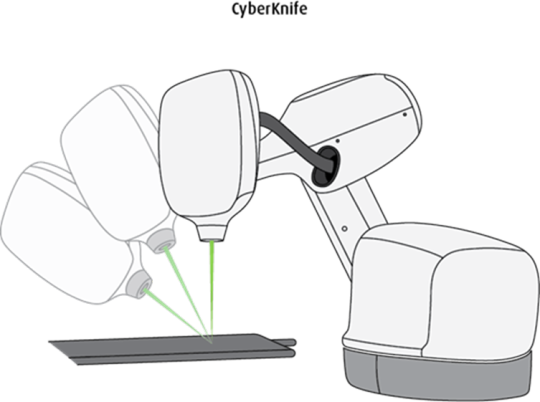
Consider me intrigued.
“CyberKnife is a small compact linear accelerator mounted on a robotic arm that moves around the person to give radiation from many different directions. Computers track a person’s position and movement. If a person moves slightly, the robotic system can adjust by repositioning before the beam of radiation is delivered.“ (cancer.ca)
TL;DR- The arm moves around the patient from different directions while a computer tells it where to shoot.

Luis really said ‘anything you can do I can do x3, under budget, and without internet’. His machine even sounds like the Cyberknife, it’s great.
The ability of both machines (Luis’ and C.K.) to ‘track’ the tumor/Plaga is interesting since it follows something called ‘Image-Guided Radiation Therapy (IGRT)’ which didn’t come into popular use until 2004.
Remember why 2004 was important but discounted from my research?
Because Luis was already on the damn island by then.
Luis either took this concept he’d seen in passing and built it, or he came up with the idea completely on his own, conceptualized it, and then built a working model in the middle of nowhere, Spain with a cult breathing down his neck.
In the same year scientists on the outside (where they can collaborate and consult other people in their fields) were able to build and release such a thing.
This, however, is one of the first places Luis’ machine differs from ‘official’ radiotherapy machines -
His imaging.
Here’s his screen:
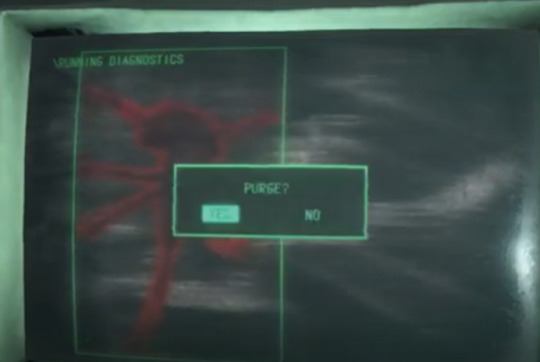
Most radiotherapy machines these days use MRI or CT scans for imaging (and Cyberknife uses X-rays).

But that’s not what his screen looks like. MRI/CT scans are too clean.
You know what his screen looks like to me though?

It looks like an ultrasound. His screen has the little gray motion lines that waver as the machine searches around for the Plaga inside of Ashley.

^See? The gray lines move around and the Plaga moves around.
This is fascinating to me since CT/MRI/X-Rays all take ‘slices’ or ‘snapshots’ of the body. You have to hold really still when they are taken.
You know what doesn’t hold still when getting imaging done?

Babies. And babies are seen using ultrasounds.
I think he utilized some form of ultrasound technology beneath/inside the chair itself to ping upward and get images of the Plaga as it moves.
Then the algorithms begin to track the Plaga once the ultrasound has brought it into view, the beams ‘lock on’, and fire radiation into the Plaga (and the poor fuckers between the radiation and the Plaga).
In some other post we can unpack the fact that apparently Luis has enough mathematical and programing know-how to build tracking algorithmns from the ground up. Mechanics? Check. Maths? Check. Programming? Jesus Christ my dude, Mensa is about to pull you over for speeding.
…And yes, I know ultrasounds are touchy and shouldn’t work with that much air between it and whatever it’s imaging, but I’m giving it the ‘sci-fi rule’: it looks like it works, so it works. This will not be the only time I invoke this rule.
Now his robotic arms.
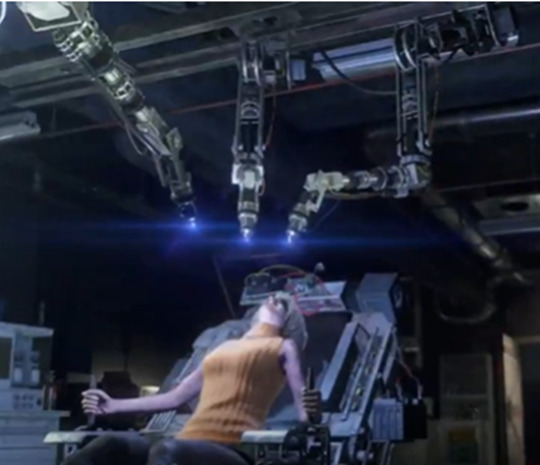
The Cyberknife has just the one, but it has similar flexibility:

Thus it would make sense for two of the arms on Luis’ machine to be for imaging like the Cyberknife:

But as we see from his display, they’re not.

All three of them are for firing radiation. When the circles all overlap, the system will fire. Luis wasn’t taking any chances with this shit. He’s hitting it fast and hitting it hard. (This will come into play later.)
Next up is his chair. Granted, the chair looks a lot more utilitarian (and sci-fi catchall) from other angles, but the very first time we see his chair it looks like this:

Following the concept that his lab is filled with things that are just a little to the left of what he needs, I would say that this looks like a surgical ‘beach chair’:

They’re meant to hold a person still while operating on an arm or shoulder. His chair looks like it has space for arm and head restraints, and the bottom of the leg rest flips up to hold the feet in place.

Et voila:

I think I’m onto something.
I also think he has a LINAC machine hidden somewhere in his lab. (We are now entering the 'way above my paygrade’ segment.)
A “LINear ACcelerator uses microwave technology to accelerate electrons then allows these electrons to collide with a heavy metal target to produce high-energy x-rays.” (radiologyinfo.org)
TL;DR - it makes radiation go brrrr so it can be shot into things
How he got one or where it’s stored are completely beyond me, since if he had gotten one by just asking for it, he would have had to answer a lot of questions that the cult (that WORSHIPS the things he’s destroying) wouldn’t be very happy with the answer to… but he wouldn’t have to hide it.
However, I don’t see one when looking around his chair.
I DO, however, see a bunch of machines that could easily be hiding one.
(Sci-fi logic says ‘what if he built one!!!!’ and imma be real with you chief, I don’t think he has the space to build a nuclear accelerator from the ground up. Hiding one though, that I’ll believe.)
It would have had to be a relatively big object since the microchip-sized LINACs weren’t conceptualized until 2015 and were only built successfully in 2023:

^Very cool. Very small. Very not possible in 2004. :'(
However, here is the rough size of different radiotherapy machines available on the market from 1956:
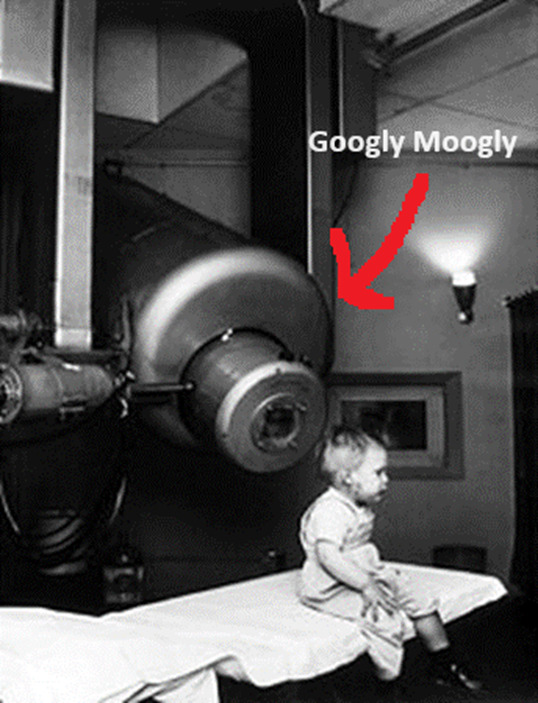
1972:

And on the Cyberknife cir. 2019, just because that’s the model I’ve been referencing:
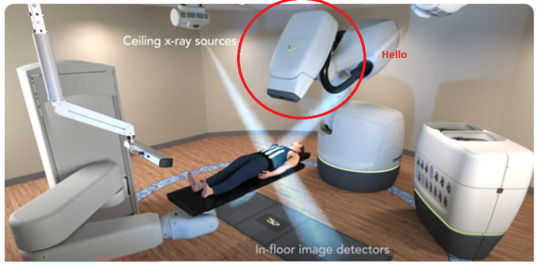
So while there are some LINAC machines that are ~3 km long, the ones used on radiotherapy machines aren’t super big. They're not microchip-size, but anything the size of a washing machine would suffice to mask this thing.
I think he could safely be hiding it somewhere physically nearby to where the robot arms come from before dividing its blast into three high-energy beams.
Which leads me to my final big difference between Luis’ machine and any market-available models:
The possibility of pain. (Told you it would be important later.)
My research says that radiation therapy shouldn’t hurt, even if sometimes local anesthesia is applied to the site before starting the treatment. (Location of treatment, type of cancer, etc.)(Sources are linked below!)
However, when radiology machines malfunction (which is rare!!! I only know of three (3) instances where a machine fucked up out of the decades we’ve been using this technology) they leave behind radiation burns and stabbing pains.
Which, ow.
But Ashley was in instant, screaming agony. Granted, I’m not sure if that was from radiation or from the Plaga embedded into her nervous system, but his machine applied three streams of radiation where traditional devices use one. Her treatment time was around 21 seconds total while traditional treatments take at least a few minutes per dose.
Personally I’m inclined to believe that it was the Plaga causing her pain, due to her scream not changing at any point (thus illustrating the source of her pain not changing from radiation to Plaga.) Even if it was a quick jolt of burning from the machine, switching over to the pain of a parasite hijacking her every nerve ending at once, there would have been some change (in my experience with chronic pain, at least).
But it can’t be ruled out. Ashley was in agony and a traditional machine would not have that effect on a patient.
At least if you’re paralyzed with pain you don’t have to worry about being held in place so the machine can do its job? Silver lining?
Sci-fi logic, my friends. Sci-fi logic.
In closing, Luis Sera MacGyver Navarro created a radiation device that not only functioned as he needed it to, but it could work repeatedly without a massive cooldown time in between uses or internal errors when operated by two amateurs who had no idea what they were doing.
And he made it out of the mechanical equivalent of paperclips, bubblegum, and the particle accelerator he’s hiding in a closet.
Sources:
Radiotherapy explanations/descriptions/history - [Siemens][MSK Cancer Center][Wikipedia][MD Anderson][Virginia Radiation][Canadian Cancer Society][National Cancer Institute][Standford Healthcare]
Surgical 'beach chair' - [hillrom.com][davidscottco.com][arthrex.com][Anesthesia Patient Safety Foundation]
Linac info/images/articles - [Space.Com][RadiologyInfo.Org][Wikipedia][Google]
RE4R Youtube Videos - ["The LORE of ALL Resident Evil 4 Enemies" uploaded by Snake Meal][Plaga removal cutscene uploaded by CrispyBenoit]
Cyberknife Youtube Videos - ["How Cyberknife Works" uploaded by Mt. Miriam Cancer Hospital]["CyberKnife® Robotic Radiosurgery System Demonstration" uploaded by ThedaCare]
Ultrasound, MRI, CT images/info - [sciencedirect.com][Mt. Auburn OB/GYN][Desert Imaging]
#I am not an expert I am a hobbyist at best pls be kind#long ass post#ask to tag#research with me#re4r meta#re4 meta#resident evil meta#luis serra navarro#pants with my hands on my knees like i just ran a marathon
69 notes
·
View notes